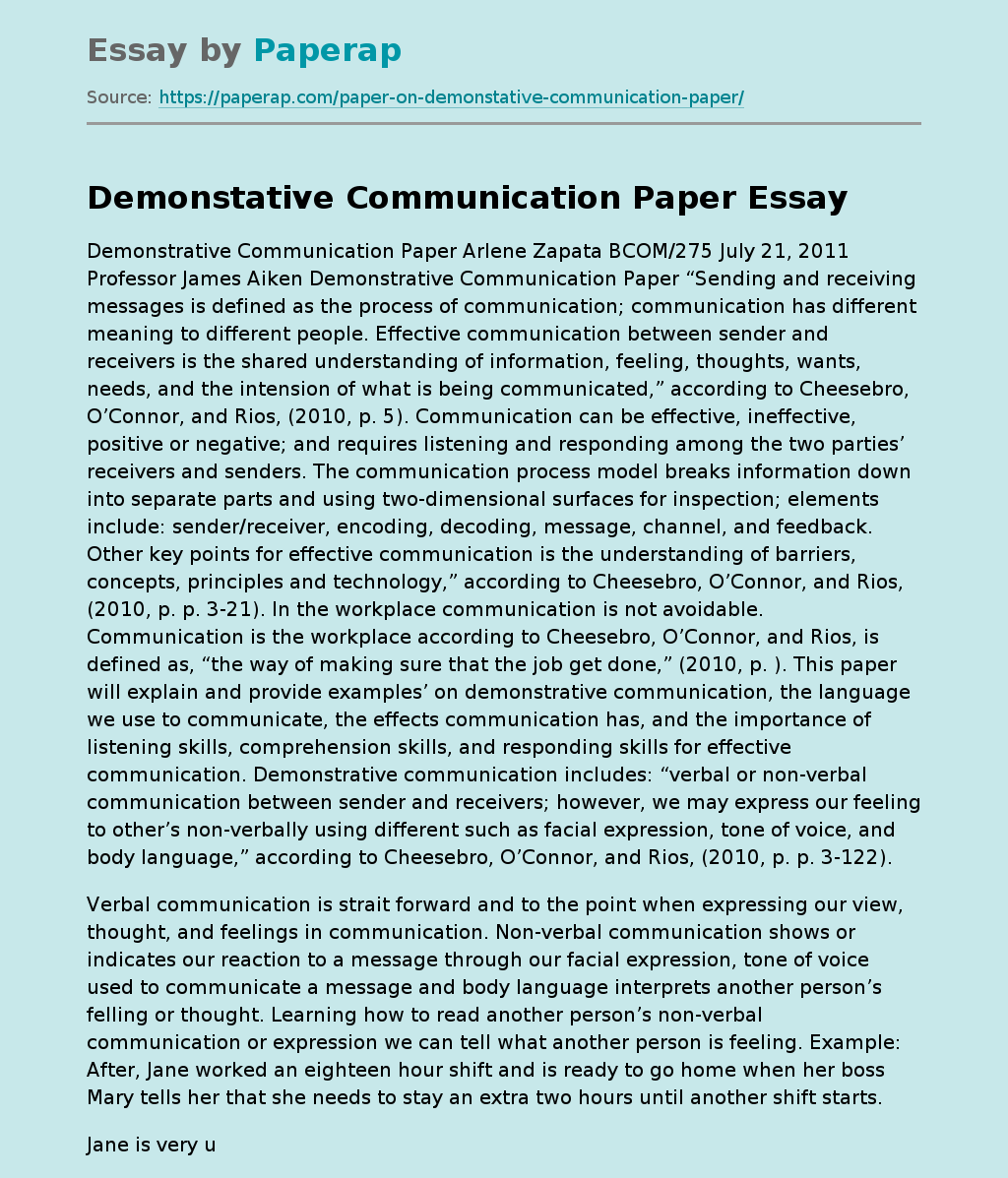Demonstative Communication Paper
Demonstrative Communication Paper Arlene Zapata BCOM/275 July 21, 2011 Professor James Aiken Demonstrative Communication Paper “Sending and receiving messages is defined as the process of communication; communication has different meaning to different people. Effective communication between sender and receivers is the shared understanding of information, feeling, thoughts, wants, needs, and the intension of what is being communicated,” according to Cheesebro, O’Connor, and Rios, (2010, p. 5). Communication can be effective, ineffective, positive or negative; and requires listening and responding among the two parties’ receivers and senders.
The communication process model breaks information down into separate parts and using two-dimensional surfaces for inspection; elements include: sender/receiver, encoding, decoding, message, channel, and feedback. Other key points for effective communication is the understanding of barriers, concepts, principles and technology,” according to Cheesebro, O’Connor, and Rios, (2010, p. p. 3-21). In the workplace communication is not avoidable. Communication is the workplace according to Cheesebro, O’Connor, and Rios, is defined as, “the way of making sure that the job get done,” (2010, p.
). This paper will explain and provide examples’ on demonstrative communication, the language we use to communicate, the effects communication has, and the importance of listening skills, comprehension skills, and responding skills for effective communication. Demonstrative communication includes: “verbal or non-verbal communication between sender and receivers; however, we may express our feeling to other’s non-verbally using different such as facial expression, tone of voice, and body language,” according to Cheesebro, O’Connor, and Rios, (2010, p. p. 3-122).
Verbal communication is strait forward and to the point when expressing our view, thought, and feelings in communication.
Non-verbal communication shows or indicates our reaction to a message through our facial expression, tone of voice used to communicate a message and body language interprets another person’s felling or thought. Learning how to read another person’s non-verbal communication or expression we can tell what another person is feeling. Example: After, Jane worked an eighteen hour shift and is ready to go home when her boss Mary tells her that she needs to stay an extra two hours until another shift starts.
Jane is very upset when Mary delivers that message. Jane sits down and totally ignores what Mary is saying. Jane decides not to say anything to her boss Mary verbally but uses nonverbal communication to express her feelings. Mary the boss may interpret Jane reaction’s of the message by reading Jane facial expression. Her facial expression expresses signs of being tired, closing her eyes, yarning, and upset. Jane’s body language expresses that she is not motivated to keep working. The tone of voice, the use of non-verbal communication expresses that silence is used to avoid conflict between Jane, and Mary.
Demonstrative communication among senders and receivers are based on the communicated message and how individual interoperates that message. Demonstrative communication can take many forms; it can be effective, ineffective, positive, or negative in communication. Using the example provided above lets interpreted the message Mary being the sender and Jane being the receiver by asking question. Was the message effective or ineffective; and was that message positive or negative based on Jane’s reaction? In this scenario the expressions used by Jane were effective and ineffective.
Effective because she expressed her feeling using non-verbal communication to her boss Mary however, ineffective because using verbal communication she could have expressed the situation in a more effective manner. Depending on which point of view that you look at either Mary’s or Jane’s the reaction is positive or negative. Jane used of nonverbal communication to express her feeling in a negative way when a positive form would have been to express her feeling verbally on long working hours. Mary might have interpreted those feeling from Jane in a negative way not aware of the situation of long working hours.
A positive interpretation by using verbal communication by Jane the line of communication would not give mixed singles and the information would have been the same for the sender and receiver. Demonstrative communication involves the importance of listening, comprehension, and responding skills for effective communication. “Listening is the process of receiving, constructing meaning from, and responding to spoken and/or nonverbal messages,” according to Cheesebro, O’Connor, and Rios, (2010, p. 105), and The International Listening Association, (1996, p. 1).
Demonstrative listening requires active listeners, “cultivating an interest of the speaker and the message, your attention by staying focused both mentally and physically of the message, understanding what is being communicated and the senders intension,” according to Cheesebro, O’Connor, and Rios, (2010, p. p. 103-122). Comprehension of what we listen and how we respond uses critical thinking skills and play an important role for effective communication. “Feedback is essential to promote understanding between a sender and receiver and can occur in a variety of forms,” according to Cheesebro, O’Connor, and Rios, (2010, p. . 115-116). Feedback using verbal or nonverbal forms in communication to expresses our individual points of view of a message play an important role in effective communication. Conclusion: Effective communication starts with effective listening skills. Communication between sender(s) and receiver(s) is the understanding or interoperation of the same message or information. Providing feedback verbally or nonverbally expresses how we the receiver understood the message or information from the sender by showing or expressing our thought, feeling, wants, and needs of the communicated message or information.
Sender(s) of a message or information should provide or be able to interoperates the receiver feedback establish an effective line of communication between both sender and receiver. Messages or information take many forms; the message can be effective, ineffective, positive, or negative learning those form and learning how to communicate verbally or nonverbally while being able to interoperates the feedback while using effective listening skills describes demonstrative communication. References: Cheesebro, T. , O’Connor, L. , Rios, F. , (2010). Communicating in the workplace. Upper Saddle River, NJ: Prentice Hall
Demonstative Communication Paper. (2018, Jul 28). Retrieved from https://paperap.com/paper-on-demonstative-communication-paper/

